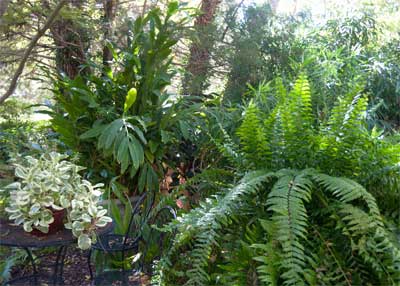From the Sperry Gardens – October, 2011

Part of the 100 large pots that will be heading into the Sperry greenhouses in the next 10 days. Look at the size of that giant ‘Macho’ fern. Compare its size to the black table to the left.
I became obsessive about my plants at an early age. By the time I was 12, I was taking cuttings from coleus, begonias and other plants that were on track to freeze before the next morning. I still feel a bit of that angst every autumn.
And, so that’s what brings us to our discussions today. How do you decide which plants should be saved and which plants can easily enough be replaced in April or May? Here are the guidelines that I’ve followed.
First and foremost: save only those plants that would be difficult to replace, either because of rarity, expense or sentimental value. Space is limited.
Second, and almost as foremost: the garage is NOT a suitable place for keeping plants for weeks or months on-end. It’s simply too cold and too dark in there. A heater might help, but it will still be way too dark. Adding lights would not make up the difference. You need a sunroom, a large window or, best of all, a greenhouse.
Some plants suffer "chilling" injury. That’s damage done by cold (but not freezing) weather. Bougainvilleas, aglaonemas, dieffenbachias and others begin to pout when temperatures drop below 45-50 F, so they need to be moved inside first. Tropical hibiscus fit into this category, too, but they often are too large to keep indoors. As with bougainvilleas, you have to decide whether you want to go to the trouble of trying to save them. You may have to do major pruning to get them inside.
Other plants will be killed by even brief exposure to 32 F. That would include most begonias, many succulents, ficuses and crotons.
Some plants can handle short-term exposure to very light freezes. That would include some non-vining philodendrons such as Philodendron selloum and some types of aloes. However, you never really know how much cold a plant can take, and you don’t know if the temperatures will drop lower than expected, so be forewarned.
Regarding Bananas and Caladiums …
Finally, to address two specific plants, I get a ton of questions on how to save bananas and caladiums each fall, and I have included the answers in the 100 Most-Asked Questions on our website. Click here to see my suggestions for bananas. Click here for caladiums.

